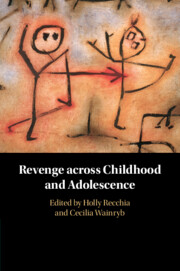Book contents
- Revenge across Childhood and Adolescence
- Revenge across Childhood and Adolescence
- Copyright page
- Dedication
- Contents
- Figures
- Tables
- Contributors
- Acknowledgments
- Chapter 1 And If You Wrong Us, Shall We Not Revenge?
- Chapter 2 A Framework for Understanding Variation in Youth Revenge Motivations and Retaliatory Behaviors
- Chapter 3 Normative Changes and Individual Differences in Retaliation Judgments
- Chapter 4 Developing Revenge in Early Childhood
- Chapter 5 Understanding Youths’ Retaliatory Experiences through the Lens of Moral Agency
- Chapter 6 Cultural Systems and the Development of Norms Governing Revenge and Retribution
- Chapter 7 Settling the Score in a Zero-Sum Game
- Chapter 8 Intergroup Processes
- Chapter 9 Revenge, Justice Systems, and Institutional Trust in Schools
- Chapter 10 The Importance of a Positive School Climate in Addressing Youth Retaliation
- Chapter 11 Socioemotional Competencies and Positive Classroom Climate as Alternatives to Prevent Revenge in Colombian Schools
- Chapter 12 Looking Back and Charting a Course
- Index
- References
Chapter 5 - Understanding Youths’ Retaliatory Experiences through the Lens of Moral Agency
Published online by Cambridge University Press: 08 July 2021
- Revenge across Childhood and Adolescence
- Revenge across Childhood and Adolescence
- Copyright page
- Dedication
- Contents
- Figures
- Tables
- Contributors
- Acknowledgments
- Chapter 1 And If You Wrong Us, Shall We Not Revenge?
- Chapter 2 A Framework for Understanding Variation in Youth Revenge Motivations and Retaliatory Behaviors
- Chapter 3 Normative Changes and Individual Differences in Retaliation Judgments
- Chapter 4 Developing Revenge in Early Childhood
- Chapter 5 Understanding Youths’ Retaliatory Experiences through the Lens of Moral Agency
- Chapter 6 Cultural Systems and the Development of Norms Governing Revenge and Retribution
- Chapter 7 Settling the Score in a Zero-Sum Game
- Chapter 8 Intergroup Processes
- Chapter 9 Revenge, Justice Systems, and Institutional Trust in Schools
- Chapter 10 The Importance of a Positive School Climate in Addressing Youth Retaliation
- Chapter 11 Socioemotional Competencies and Positive Classroom Climate as Alternatives to Prevent Revenge in Colombian Schools
- Chapter 12 Looking Back and Charting a Course
- Index
- References
Summary
In this chapter, we consider how youth make sense of their own retaliatory goals and actions in the aftermath of being harmed, and we elaborate on the implications of their meaning-making for processes of moral development and behavior. We begin by describing how youths’ experiences of revenge are distinct from other forms of harmdoing, and how these unique features of revenge may inform the meanings that they construct from their retaliatory desires and actions. Next, we describe age-related changes in these constructive processes, and discuss how youths’ histories of interactions in their social milieu may undergird their constructions of meaning about revenge. We conclude by articulating implications of our analyses for intervening with children and adolescents surrounding issues of revenge.
Keywords
- Type
- Chapter
- Information
- Revenge across Childhood and Adolescence , pp. 100 - 126Publisher: Cambridge University PressPrint publication year: 2021

